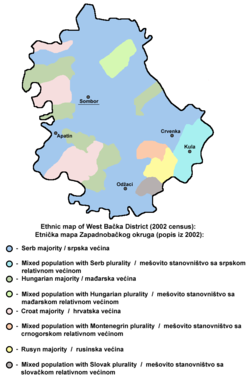|
West Bačka District
The West Bačka District (Serbian: Западнобачки округ, romanized: Zapadnobački okrug, pronounced [zâːpadnobâːtʃkiː ôkruːɡ]; Hungarian: Nyugat-bácskai körzet) is one of seven administrative districts of the autonomous province of Vojvodina, Serbia. It lies in the geographical region of Bačka. It has a population of 154,491 inhabitants. The administrative seat of the district is the city of Sombor. NameIn Serbian, the district is known as Zapadnobački okrug or Западнобачки округ, in Croatian as Zapadnobački okrug, in Bunjevac as Zapadnobački okrug, in Hungarian as Nyugat-bácskai körzet, in Slovak as Západnobáčsky okres, in Rusyn as Заходнобачки окрух, and in Romanian as Districtul Bacica de Vest. Administrative historyIn the 9th century, the area was ruled by the Bulgarian-Slavic duke Salan. From 11th to 16th century, during the administration of the medieval Kingdom of Hungary, the area was divided between the Bodrogiensis County, Bacsensis County, and Csongradiensis County. In 1526–1527, the area was ruled by the independent Serb ruler, emperor Jovan Nenad, while during Ottoman administration (16th-17th century), it was part of the Sanjak of Segedin. During Habsburg administration (18th century), the area was divided between the Batsch County, Bodrog County and the Military Frontier. The two counties were joined into single Batsch-Bodrog County in the 18th century. Since the abolishment of the Theiß-Marosch section of the Military Frontier in 1751, part of that territory was also included into Batsch-Bodrog County. In the 1850s, the area was mostly part of the Sombor District, with some parts in the Novi Sad District. After 1860, the area was again included into Batsch-Bodrog County. During the royal Serb-Croat-Slovene (Yugoslav) administration (1918–1941), the area was part of the Novi Sad County (1918–1922), Bačka Oblast (1922–1929), and Danube Banovina (1929–1941). During the Hungarian-German Axis occupation (1941–1944), the area was included into Bács-Bodrog County. Since 1944, the area was part of autonomous Yugoslav Vojvodina (which was part of new socialist Yugoslav Serbia since 1945). The present-day districts of Serbia (including West Bačka District) were defined by the Government of Serbia's Enactment of 29 January 1992. Municipalities  It encompasses the municipalities of: Demographics
According to the census done in 2011, the West Bačka had 188,087 inhabitants. Ethnic groups
CultureSombor is a town of rich cultural tradition with numerous buildings of significance including: Prefecture Hall (Županija), City Hall (Gradska Kuća), Milan Konjović Gallery, Serbian Orthodox Church of St George, Roman Catholic Church of Holy Trinity.[2] The iconostasis of the Serbian Orthodox church in Stapar was painted by Jakov Orfelin in the late 18th century. It is a protected monument registered as cultural heritage, bearing witness to the long history of this town.[3] Historic St Nicholas Cathedral in Ruski Krstur was built in 1784 and underwent a major reconstruction in 1836. The walls were painted in 1936 by Milenko Djurić. The church is under the protection of the Republic of Serbia, as a cultural monument of great importance.[4] See alsoReferences
External linksWikimedia Commons has media related to West Bačka District. |
||||||||||||||||||||||||||||||||||||||||||||||||||||||||||||||||||||||||||||||||||||||||||||||||||||||||||||||||||||||||||||||||||||||||||||||
Portal di Ensiklopedia Dunia















